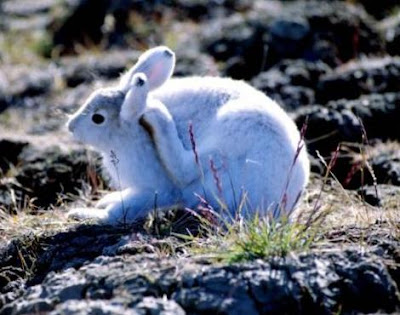Animals Unique | Arctic Hare Unique | The Arctic hare is found in the northern regions of the Arctic Circle, predominantly in Northern America, Europe, Greenland and the North Pole. The Arctic hare has thick, white fur the which allows it to continue inhabiting the Arctic regions successfully, in warmth and camouflage.
The Arctic hare eats shoots, buds and berries found amongst the snow. The Arctic hare is a vital component in the Arctic food chain circle, being one of the few smaller Mammals Able to Thrive in Such a harsh environment.
The Arctic hare is therefore common prey for bigger animals of the Arctic tundra, Such as Arctic wolves, foxes and polar bears. The Arctic hare is always white in the far north where there is snow all year round. In parts of the Arctic Circle That have seasons, the Arctic hare will go from white to a blue-gray color in the summer but is known to keep its white tail all year.
The Arctic hare lives in groups of around 200 individuals Arctic hare. These large groups of Arctic hares will work together to Achieve Often what is needed for Their survival as the Arctic Hares Huddle together to conserve heat and to keep them warm. The Arctic hare has long claws the which helps the Arctic hare when digging through icy and snowy conditions when the Arctic hare is searching for food or if the Arctic hare is digging a den.
The Arctic hare can Achieve very fast speeds when the Arctic hare feels Threatened. If the Arctic hare senses danger, the Arctic hare will stand on its Hind legs and survey the area. If the Arctic hare feels Threatened, the Arctic hare is capable of taking off at very fast speeds as the Arctic hare moves by hopping off its back legs in a similar way to a kangaroo.
Arctic Hare Unique Facts Kingdom: Animalia Phylum: Chordata Class: mammals Order: Lagomorpha Family: Leporidae Genus: Lepus Scientific Name: Lepus Arcticus Type: Mammal Diet: Herbivore Size (L): 48cm - 67cm (19in - 26in) Weight: 4kg - 5kg (9lbs - 12lbs) Top Speed: 64km / h (40mph) Life Span: 3-8 years Lifestyle: Herd Conservation Status: Least Concern Colour: White, Grey Skin Type: Fur Favourite Food: Grass Habitat: Tundra and rocky areas Average Litter Size: 6 Main Prey: Grass, Willow, Flowers Predators: Snowy Owl, Fox, Wolf Distinctive Features: Thick fur color changes with seasons That





No comments:
Post a Comment